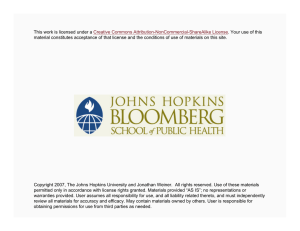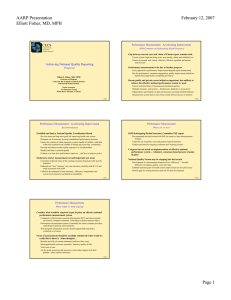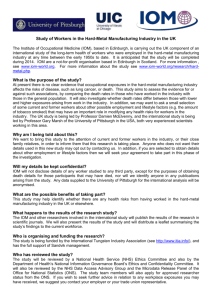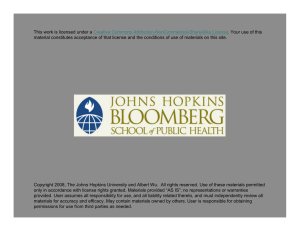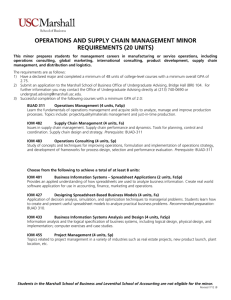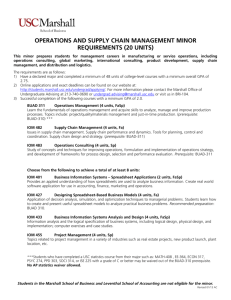The State of Health Care Quality in America
advertisement
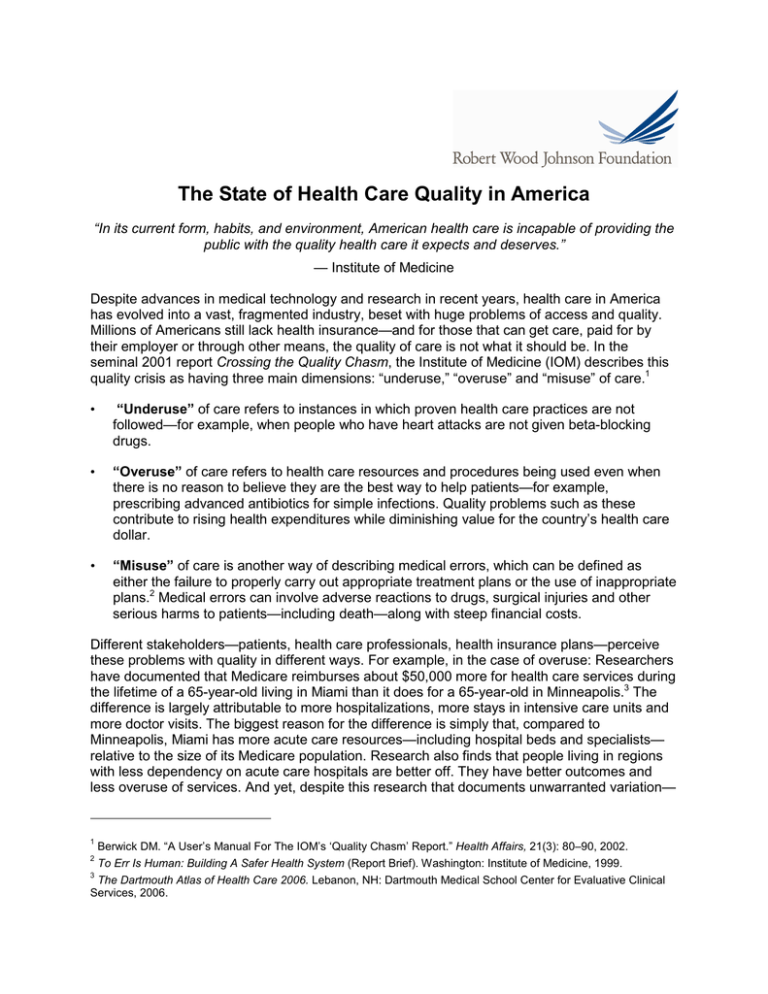
The State of Health Care Quality in America “In its current form, habits, and environment, American health care is incapable of providing the public with the quality health care it expects and deserves.” — Institute of Medicine Despite advances in medical technology and research in recent years, health care in America has evolved into a vast, fragmented industry, beset with huge problems of access and quality. Millions of Americans still lack health insurance—and for those that can get care, paid for by their employer or through other means, the quality of care is not what it should be. In the seminal 2001 report Crossing the Quality Chasm, the Institute of Medicine (IOM) describes this quality crisis as having three main dimensions: “underuse,” “overuse” and “misuse” of care.1 • “Underuse” of care refers to instances in which proven health care practices are not followed—for example, when people who have heart attacks are not given beta-blocking drugs. • “Overuse” of care refers to health care resources and procedures being used even when there is no reason to believe they are the best way to help patients—for example, prescribing advanced antibiotics for simple infections. Quality problems such as these contribute to rising health expenditures while diminishing value for the country’s health care dollar. • “Misuse” of care is another way of describing medical errors, which can be defined as either the failure to properly carry out appropriate treatment plans or the use of inappropriate plans.2 Medical errors can involve adverse reactions to drugs, surgical injuries and other serious harms to patients—including death—along with steep financial costs. Different stakeholders—patients, health care professionals, health insurance plans—perceive these problems with quality in different ways. For example, in the case of overuse: Researchers have documented that Medicare reimburses about $50,000 more for health care services during the lifetime of a 65-year-old living in Miami than it does for a 65-year-old in Minneapolis.3 The difference is largely attributable to more hospitalizations, more stays in intensive care units and more doctor visits. The biggest reason for the difference is simply that, compared to Minneapolis, Miami has more acute care resources—including hospital beds and specialists— relative to the size of its Medicare population. Research also finds that people living in regions with less dependency on acute care hospitals are better off. They have better outcomes and less overuse of services. And yet, despite this research that documents unwarranted variation— 1 Berwick DM. “A User’s Manual For The IOM’s ‘Quality Chasm’ Report.” Health Affairs, 21(3): 80–90, 2002. To Err Is Human: Building A Safer Health System (Report Brief). Washington: Institute of Medicine, 1999. 3 The Dartmouth Atlas of Health Care 2006. Lebanon, NH: Dartmouth Medical School Center for Evaluative Clinical Services, 2006. 2 meaning, regional variations in care that are not attributable to how sick people are or how much care they need—there are no clear incentives or solutions to the problem. No one entity can tell a particular hospital or a region to stop providing too much care; fixing our health care system requires collective and concerted action at a level that has not happened to date. Underuse problems are equally pronounced. For example, the American Cancer Society recommends yearly breast exams for women starting at age 40. But as of 2006, only 55 percent of women in that age group were getting them.4 Such lapses in recommended care are pervasive in the U.S. health care system. In fact, RAND studies have found that, on average, Americans receive only about 55 percent of the health care services recommended for their medical conditions.5 6 For children, the situation is even worse. They receive only about 47 percent of the recommended care.7 And then there is misuse of care. Perhaps the most appalling illustration of that problem comes from IOM’s 1999 report on medical errors, To Err Is Human. It found that at least 44,000 people—and perhaps as many as 98,000—die in hospitals each year as a result of medical errors that could have been prevented.8 The cumulative impact of these quality issues is that the U.S. health care system—the most expensive health care system in the world—consistently underperforms relative to other countries. One study comparing the United States to Australia, Canada, Germany, New Zealand and the United Kingdom found that America ranked at or near the bottom of the list on most dimensions of quality, from safety, to coordination of care, to the degree to which the system focuses on patients’ interests.9 The costs of all of these quality failures are enormous. A glaring example is in the case of chronic disease. According to a 2007 Milken Institute report, people with chronic health conditions cost the United States more than $1 trillion a year, a figure that could jump to nearly $6 trillion by 2050 unless the provision of preventive health services substantially improves.10 So what do we do about the quality crisis? The Quality Chasm report calls for sweeping reform of the U.S. health care system—“nothing less than a redesign,” according to one of its lead contributors.11 The report says the goal of a reform effort should be to ensure that health care is marked by six essential attributes: It should be safe, effective, patient-centered, timely, efficient and equitable. 4 Cancer Prevention & Early Detection Facts & Figures 2006. Atlanta: American Cancer Society, 2006. 5 McGlynn EA, Asch SM, Adams J, Keesey J, Hicks J, DeCristofaro A and Kerr EA. “The Quality of Health Care Delivered to Adults in the United States.” New England Journal of Medicine, 348 (26): 2635-45, 2003. 6 Asch SM, Kerr EA, Keesey J, Adams JL, Setodji CM, Malik S and McGlynn EA. “Who Is at Greatest Risk for Receiving Poor-Quality Health Care?” New England Journal of Medicine, 354 (11): 1147-56, 2006. 7 Mangione-Smith R, DeCristofaro AH, Setodiji CM, Keesey J, Klein DJ, Adams JL, Schuster MA and McGlynn EA. “The Quality of Ambulatory Care Delivered to Children in the United States.” New England Journal of Medicine, 357 (15): 1515-23, 2007. 8 To Err Is Human: Building A Safer Health System. Washington: Institute of Medicine, 1999. 9 Davis K, Schoen C, Schoenbaum SC, Doty MM, Holmgren AL, Kriss JL and Shea KK. Mirror, Mirror on the Wall: An International Update on the Comparative Performance of American Health Care. New York: The Commonwealth Fund, 2007. 10 Bedroussian A, DeVol and Ross. “An Unhealthy America: The Economic Burden of Chronic Disease.” Santa Monica, CA: The Milken Institute, 2007. 11 Berwick, op. cit. In To Err Is Human, IOM concluded that “exhortation, blaming, and ‘trying harder’ are not acceptable plans for improving patient safety; rather, we should be pursuing the much more scientifically valid plan of substituting new, reliable system designs for old, unreliable ones.” Quality Chasm went further, tying quality issues more closely to patients’ experiences, cost and even social justice. To improve quality in these areas, IOM specifically recommended following three principles: It said improvements should focus on making sure that care is “knowledgebased,” “patient-centered” and “systems-minded.” Many health care leaders and professionals have tested incremental and technical approaches to improving health care, similar to system redesign initiatives that have taken hold in large corporations. These approaches have yielded case studies and examples of how individual institutions and specific health care systems around the country have improved care. To go beyond these individual examples, the Robert Wood Johnson Foundation is investing in targeted regions across the country and working with multiple stakeholders in these areas to improve health care across the spectrum. This regional strategy, called Aligning Forces for Quality, enlists doctors, nurses, hospitals, patients, consumer groups, employers, health plans and other health professionals to work together to improve quality in ways that transform health care for patients from all racial and ethnic backgrounds. The central goals of Aligning Forces are: • To help providers improve their own ability to deliver quality care. • To help providers measure and publicly report their performance, as a fundamental means to understand where quality gaps are occurring. • To help the major forces that influence health care in any one place—such as businesses, health plans, doctors, nurses, and patients—align around some fundamental goals for change. • To help patients and consumers understand their vital role in recognizing and demanding quality health care.
